
 |
|||||||||||||||
December Fly-Bys
|
|
A runway incursion is any occurrence in the airport runway environment involving an aircraft, vehicle, person or object on the ground that creates a collision hazard or results in a loss of required separation with an aircraft when taking off, intending to take off, landing, or intending to land. |
||
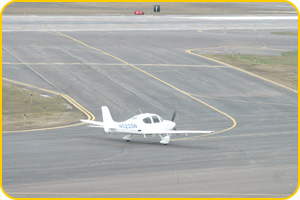 We suggest that, if you haven’t
already done so, you visit the excellent AOPA online runway safety
course. Click here and invest just a few minutes of your time to
review the fundamentals of runway safety and incursion avoidance.
What you learn—and practice—will help protect you, your
Cirrus airplane and every pilot and airplane at every airport you
visit.
We suggest that, if you haven’t
already done so, you visit the excellent AOPA online runway safety
course. Click here and invest just a few minutes of your time to
review the fundamentals of runway safety and incursion avoidance.
What you learn—and practice—will help protect you, your
Cirrus airplane and every pilot and airplane at every airport you
visit.
In the meantime, every time you prepare for takeoff or landing, keep in mind the following eight keys to runway safety:
1. ALWAYS use an airport
diagram.
Before you get into the cockpit, have in
hand a diagram of the airport. Before you start your engine, and
before your
approach in the air, study the diagram and map your taxi routes.
Air traffic controllers say that an airport diagram is a priority
for avoiding runway incursions—and a tool that pilots frequently
neglect to use.
To obtain a taxi diagram for virtually any airport, click here.
2. Develop a system for departure.
- Get your departure clearance and program your GPS before beginning to taxi.
- Review the airport diagram for your expected taxi route.
- Listen to ATIS.
- Get taxi clearance.
- Read back clearance.
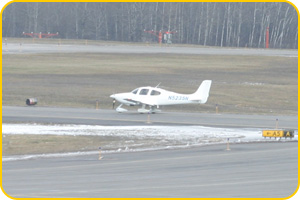 3. Understand, read and heed all
runway signs and markings.
3. Understand, read and heed all
runway signs and markings.
4. Develop and practice situational awareness
at all times.
Situational awareness means knowing where you are,
where you are going and what
traffic is around you.
- Plan and manage all cockpit activities at all times.
- Think and act defensively at both towered and non-towered airports. Do not allow another pilot’s mistake to jeopardize your safety.
5. Obey all taxi rules and directions from ATC. A few basics:
- Do not trespass on a movement area without clearance from ATC.
- When there are multiple runways and only one runway is active, a clearance to the active runway authorizes you to cross all movement areas and all inactive runways. You can taxi everywhere except on the active runway, and you must use the full length of the taxiway unless ATC instructs otherwise or unless you request and receive approval for an intersection departure.
- Read back precisely and exactly all instructions you receive from ATC. If you fail to do so, the controller will continue to instruct you until your read-back is exact. Write down all clearances for reference—don’t rely solely on your memory.
- When you’re holding short of the runway for takeoff, be sure to hold short of the hold-short line. When you’re holding short as you clear the runway, clear or pass the hold-short line and hold short of the next taxiway, unless instructed otherwise.
- If you become lost or disoriented during taxiing, STOP and ask ATC for directions or clarification. You must know your position and be clear about what you are doing at every moment you are on the taxi- or runway.
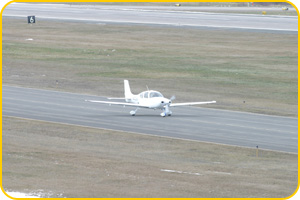 |
6. Keep your head up, your eyes on the taxi- or runway and your entire focus on safely taxiing.
|
7. After receiving ATC clearance for takeoff or landing, always visually verify that the runway, approach and departure areas are clear.
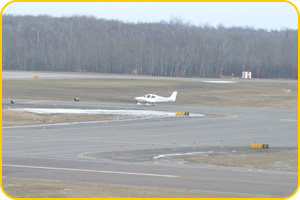 8. Develop a system for arrival.
8. Develop a system for arrival.
- Listen to ATIS for 20 minutes before arrival.
- Review the airport diagram for expected taxi routes.
- Ensure that you are clear of the runway.
- Contact ground—note any changes from your expected route
- Read back clearance.
Information courtesy of:
Mr. Dave Norden
Operations Supervisor
Duluth Air Traffic Control Tower
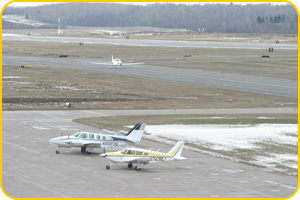 However, to best protect your safety and that of
other pilots, you also need to heed the rules of the taxi- and runway.
Taxiing—from parking—to the runway for takeoff and—after
landing—from the runway to parking demands good planning, clear
knowledge of taxi- and runway procedures, and your undivided attention
and skillful execution at every moment. Anything less increases your
risk of a runway incursion, one of the most dangerous of airport
events.
However, to best protect your safety and that of
other pilots, you also need to heed the rules of the taxi- and runway.
Taxiing—from parking—to the runway for takeoff and—after
landing—from the runway to parking demands good planning, clear
knowledge of taxi- and runway procedures, and your undivided attention
and skillful execution at every moment. Anything less increases your
risk of a runway incursion, one of the most dangerous of airport
events.